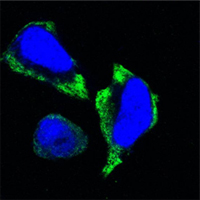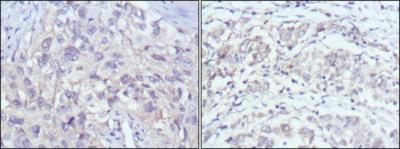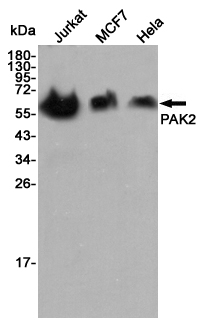-
Product Name
Anti-PAK2 (7H3) Mouse antibody
- Documents
-
Description
PAK2 (7H3) Mouse monoclonal antibody
-
Tested applications
WB, IHC-P, ICC/IF
-
Species reactivity
Human, Monkey
-
Isotype
Mouse IgG1
-
Preparation
Antigen: Purified recombinant fragment of PAK2 expressed in E. Coli.
-
Clonality
Monoclonal
-
Formulation
Ascitic fluid containing 0.03% sodium azide.
-
Storage instructions
Store at 4°C short term. Store at -20°C long term. Avoid freeze / thaw cycle.
-
Applications
WB: 1/500 - 1/2000
IHC: 1/200 - 1/1000
ICC: 1/200 - 1/1000
ELISA: 1/10000
-
Validations

Confocal immunofluorescence analysis of Hela cells using PAK2 mouse mAb (green). Blue: DRAQ5 fluorescent DNA dye.

Immunohistochemical analysis of paraffin-embedded human lung cancer (left) and gastric cancer (right) using PAK2 mouse mAb with DAB staining.

Western blot detection of PAK2 in Jurkat,MCF7 and Hela cell lysates using PAK2 mouse mAb (1:5000 diluted).Predicted band size:61KDa.Observed band size:61KDa.
-
Background
Swiss-Prot Acc.Q13177.PAK2, also known as P21 (CDKN1A)-activated kinase 2. The p21 activated kinases (PAK) are critical effectors that link Rho GTPases to cytoskeleton reorganization and nuclear signaling. The PAK proteins are a family of serine/threonine kinases that serve as targets for the small GTP binding proteins, CDC42 and RAC1, and have been implicated in a wide range of biological activities. PAK2 is activated by proteolytic cleavage during caspase-mediated apoptosis, and may play a role in regulating the apoptotic events in the dying cell. PAK2 has been shown to interact with SH3KBP1, CDC42 and Abl gene.
Related Products / Services
Please note: All products are "FOR RESEARCH USE ONLY AND ARE NOT INTENDED FOR DIAGNOSTIC OR THERAPEUTIC USE"
